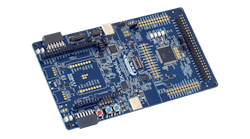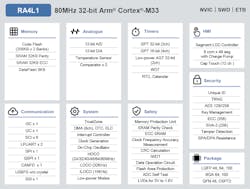Equipped with display capabilities, the low-power Renesas RA4L1—an 80-MHz Arm Cortex-M33-based micro—has 512 kB of dual-bank flash memory but also supports eXecute-in-place (XIP) operation via a quad SPI (QSPI) interface (Fig. 1). There’s also 8 kB of data flash, and the 64 kB of SRAM has parity and ECC support. The LCD drivers and capacitive-touch support provide basic human-machine-interface (HMI) chores.
The RA4L1 peripheral complement includes:
- 6x SCI (UART, Simple SPI, Simple I2C)
- 2x low-power UARTs with 32-kHz support
- SPI/I2C multi-master interface
- I3C interface
- USB 2.0 FS
- CAN FD
- 32- and 16-bit timers, 32-bit ultra-low-power timers
- 2x watchdog timer
- Real-time clock (RTC)
- 12-bit ADC and 12-bit DAC
- Low-power analog comparator
- Temperature sensor
- 8 × 48 segment LCD drive
- 12-channel capacitive touch
- Serial sound interface (SSI)
The Cortex-M33 supports Arm’s TrustZone. Also in the mix is a hardware random number generator (RNG); each chip has a unique ID.
The RA4L1 can run on power sources down to 1.6 V. Standby current can be as little as 1.65 µA. It handles temperatures from −40 to +125°C.
Development boards for the RA4L1 (Fig. 2) are supported by Renesas’ Flexible Software Package (FSP). This includes drivers and support for Azure RTOS (now the Eclipse ThreadX project) and FreeRTOS. It also includes the Eclipse-based e2 Studio IDE.



